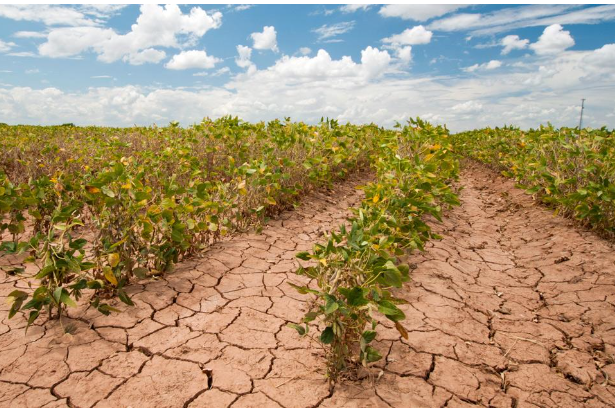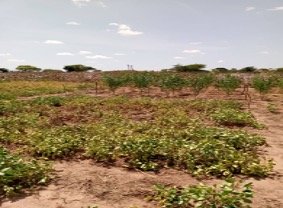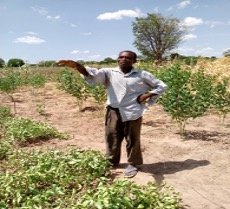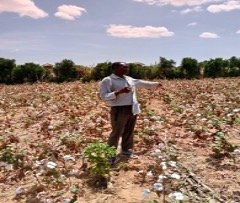STRIDES MADE IN CLIMATE ADAPTATION IN CLIMATE IN SUB-SAHARAN AFRICA: A CASE STUDY OF SUSTAINABLE LIVELIHOOD OF RURAL POOR IN THE ZAMBEZI VALLEY, SOUTHERN ZAMBIA

Author: EUGINE MWEEMBA
Key Messages
- Zambia is a landlocked country located in the heart of southern Africa with national territory occupying about 752,614 square kilometres and consist primarily of grassland and forest.
- Zambia has been experiencing drought, dry spells, season flash floods and high temperatures for decades as a result of climate change (CIAT and World Bank, 2017).
- To address climate change challenges in Zambia, Climate Smart Agriculture concept was introduced in 2009, and went further transformation and implementation (Chavula, 2022).
CONSERVATION TYPES OF AGRICULTURE
There are three types of Conservation agriculture in Zambia., hand hoe based CA and Animal draft (AD) with different application in the field. The third tractor based or mechanized is not widely used by small-scale farmers but usually medium and commercial farmers.
- Hand-hoe type of Conservation Agriculture involves digging permanent planting basins which are spaced out at 0.7 metres along the rows with 0.9 metres between rows using a chaka hoe (CFU, 2009b) Nyanga, 2012). Furthermore crop residues and vegetative matter are retained on the surface acting as permanent matter to cover organic matter in depth deep and 0.3 metres in length and 0.15 metre wide (CFU, 2009b; Nyanga, 2012). Basins improves water penetration and harvest water is greatly. These basins facilitate management support and input supply by enabling support agencies to package inputs in standard one lima (0.25ha) packs ( Haggblades and Tembo.2003a).
- Animal Draft Powered CA (ADP Ripping).
This type is used by those small-scale farmers who owns animal draft power. ADP ripping usually uses a magoye ripper (CFU, 2011; Nyanga, 2012. Framers that are practicing ADP ripping make at least 0.15-020 metres deep ripped furrows (ripe lines at 0.9 metres spacing (Nyanga, 2012). ADP ripping involves retention of crop residues and vegetative matter between ripped lines (CFU, 2009a).
Why smart agriculture?
Conservation agriculture is an approach that uses three core concept that involves (1) minimum soil disturbances; no till or minimum tillage, (2) keeping the soil surface covered with mulch or cover crops and crop rotation. it is called smart because it can reduce carbon losses by ploughing, add to the organic matter in the soil and reduce erosion. Furthermore it reduces the use of fossil fuels since avoiding ploughing saves fuel. It can also offer several benefits, including provision of stable yields, drought buffering, reduced field preparation costs, reduction of soil erosion and contributions to climate change mitigation (FAO, CYMMYT and CCAFS, 2014).
Soil and Water Conservation
It is one of smart agriculture that prevent and conserve moisture thereby maintain and improve soil fertility. Various methods are applied to achieve this and in this case physical measure that involves moving stones and earth, terraces, bunds contours, check dam, reservoir, grassed waterways diversion drains are used to discourage erosion and only encourage water infiltration.
Mulching and residue management
A technology where crop should be 30% at the time of emergency covered by organic resides from previous crop (Erenstein, 2002). In this case, residues are utilized for soil and conservation. On the other hand, soil organic inputs and livestock feed are vital in smallholding building and maintaining soil nutrient stocks.

Fig. 1 Mulching and residue management in Lusitu village.
Source: Field data,2023.
Studies by Mapfumo and Mtambanengwe, (1999) in Zimbabwe indicates that nitrogen and phosphorus are lost through the removal of maize stovers from the fields. Therefore mulching offers opportunities to address soil fertility and weed management constraints (Erenstein, 2003). Mulching also improves infiltration and soil cover that provides effective protective against splash erosion and surface runoff.
Agroforestry system
Forestry ecosystem plays vital role in life support of biodiversity, however its existence is threatened by several anthropogenic factors such as clearing for agriculture, use of fire wood, accidental fires and climate change. It has been in existence and practiced for so many decades globally and can be distinguished based on dominants components such as agrisilviculture, silvopasture, agrosivopasture, silvoagropasture, and pastural silviculture. Furthermore other system exits and are being practiced elsewhere such as apiculture with trees, aqua-forestry mixed with woodlot. Though these components do differ in dimension and time duration (Nair, 1985, Beetz, 2011, Gold et al, 2013). Agroforestry globally practiced are improved fallow with the duration of about 3-4 years period with nitrogen fixing trees/ shrubs alley cropping (trees planted in alleys, with crops between the alleys), taungya (plantation forestry allowing farmers to plant crops in young stands, home garden (multi-storery structures like garden, growing many tree for different purposes on the farmland, boundary planting, farm woodlots, orchards and tree gardens.
Agroforestry being one of the pillars of climate smart agriculture contributes considerably to food as well as amelioration to the environment subsequently to mitigation of climate change. In Africa, generally Zambia in particular smallholder farmers depends on land for their livelihoods and its ability to produce food, feed, fibre and incentives.
Concept and principles of Agroforestry
Agroforestry is different from traditional forestry by including closely related associated agricultural or forage crop. Systems of agroforestry differ in principle hence practices change based on the needs of a farmer and result may also differ depending on the set target under which agroforestry is practiced. There are 4 I s key principle that are used in land use practice ( Gold, et al., 2013).
- Intentional : this is the combinations of trees , crops/or animals intentionally designed , managed in totality than individual in order to yield multiple products and benefit.
- Intensive : This an agroforestry practice that are intensively managed to maintain their productive and protective functions. These functions usually involves annual operations such as weeding, cultivation, pruning, pollarding and fertilizer application.
- Interactive: This is a biological and physical interaction between the tree, crop and animal components are manipulated to give result of multiple products and benefit.
- Integrated: In this arrangement, tree crop or animal component are structurally and functionally combined into a single integrated management unit. It may be horizontal or otherwise.
Economic Benefits
There are a number of benefits that are accrued as a results of Agroforestry which includes the reduction of agricultural inputs, when using leguminous species which fix nitrogen to improve soil fertility. Furthermore, this maintain or increases production and diversify production in farming systems, such as food, fodder, building material and wood fuel.
Social Benefit
Apart from economic benefit, there is improvements to health and nutrition of the rural poor. Furthermore on-farm production of several products are usually collected from off-farm sources hence reduce time and effort required to gather them and lessen burden on women generating money when selling the products.
Environmental Benefits
Improving soil fertility which will results as of soil erosion will be lessen and also crops and livestock protection from wind, restoring degraded lands and water conservation if well managed. Agroforestry can also contribute to biodiversity conservation and climate change adaptation, however, if not well managed, agroforestry can cause decrease in production because of competition among trees and crops.
Agroforestry as Smart Agriculture
Studies by ( Mbow et al., 2014) in Zimbabwe indicates that when trees are planted in the field, they act as live fences, wind break, alley cropping, fodder banks, woodlots and further improves fallow which sequestrate carbon into biomass and soil thereby support wood fuel, poles and other forest based products hence prevent destruction on natural forest. In West Africa, studies shows that agroforestry has been widely acknowledged as one of the component of smart agriculture and is certainly widely used land use system (FAO, 2010). It has achieved tremendous impacts to climate change.
Tougian (eta l., 2009) reports that Faidehebia albida, Ziziphus spina, and Z. mauritiaca, Bauhimia reticulate, Guiera senegalensi were naturally regenerated to reduce desertification and improve soil fertility. According to research findings, the FMNR in Niger, has culminating into planting about two hundred million trees ( Tougian, et. al.2009) which has resulted into soil fertility benefits and providing biomass for household energy (such as charcoal and firewood) and contributing to food security for about 2.5 million people (Garrity eta. L.2010). it was reported that the benefit on bioenergy and food was valued at US$ 56 ha-1 yr-1, or a total value annually being US$280 million (Garry et al., 2010; Sendizmir., 2011;Neate,2013). Trees act as windbreak, as well as shelterbelts making cultivated fields resilient to wind storms posed by climate extremes. Fodder species such as vitellarea paradoxa, parkia biglobosa, khaya senegalis, Adansonia digitata and faidehebia albida are some of the species whose leaves are harvested and fed to livestock (Martin et al.,.2016) especially during drought period and when the grass is scarce.
In Malawi, Faidhebia albida or winter thorn or Musangu is usually associated with agroforestry system along the lake shore as it strives in most of the soils and climate. According to studies (Kaczan, Arsland and Lipper, 2013), Faidehebia albida improves soil’s ability to hold water and is able to fix nitrogen and increase amount of carbon stored both above ground and in the soil.
Agroforestry being smart contribute to crop production (Ajayi and Catacutan, 2012; Sileshi and Mafongoya, 2006; kutanshula eta l., 2006 and enhance ecosystem services (Sileshi eta l., 2007). It also boost household access to wood energy, and integrating fodder trees improves animal feed availability as well as pasture productivity. Furthermore, Agroforestry trees if planted in the right place reduces soil erosion and sequester substantial amounts of carbon.
According to a research conducted in Zambia, small scale farmers and agricultural landscape are insulated against effect of climate variability (FAO/IAEA, 2008) and also to some degree those farmers adopting agroforestry are benefiting from the emerging carbon markets such as REDD+.
Policy Recommendation
Crop Diversification
It is one of the climate smart technique which is applied to the cropping system such as taxanomy, genetic habitat and functional diversity. The specific diversity usually translate into high and stable resilient systems (Cardinale et al., 2012; Elmqvist et al., 2003; Wan et al., 2020). If disturbance affect single species, the average effect on the community is reduced, a concept also called portifolio effect (Schindler et al., 2015). With crop diversification, farmers are able to influence the biodiversity both underground and the surface and within the vicinity of the crop field hence translate its benefits to the ecosystem in terms of soil fertility and other biological control of pests (kremen &Miles, 2012).

Fig. 2 .Climate smart Agriculture in Lusitu Village.
Source: Field Data, 2023.
Crop rotation
Crop rotation is one of smart agriculture which allows a succession of two or more crop species in the same field. It helps to provide resilient to adverse weather conditions and pest outbreak which maybe necessitated by climate change (Fitt et a., 2016). In addition, crop rotation reduces maize failure under stress conditions (Bowles et al.,2020) and also improves yield stability in maize and soybean (Gaudin et al., 2011)
.

Fig. 3 A farmer explaining how climate Smart Agriculture is done in Lusitu village.
Source: Field Data, 2023.
Studies has shown that in cropping rises plant litter accumulation input to the ground which enable high microbial activity (Hattenswchwiler eta l., 2005) Microbes are part of the fauna within the biodiversity that are able to decompose soil organic matter (SOM), which includes plants residues, releasing nutrients such P and N resulting into stable SMO (SSMO) as final product (Centrufo eta l.,2015). SSMO improves soil properties resulting into soil water capacity infiltration. These properties regulate water and nutrient retention (Yang eta l., 2014) which provide resilience to drought (Hueso et al., 2011).
REFERENCES
[1] Ajay Olu C., Franzel,S., Kuntashula, E., and Kwesiga, F., (2003). Adoption of improved fallow technology for soil fertility management in Zambia: Empirical studies ad emerging issues. Agroforestry Systems, 59(3), 317-326.
[2] Ajayi, Oluyede Clifford, Place, F., Akinnifesi, F.K., and Sileshi, G.W., (2011). Agricultural Success from Africa: The case of fertilizer tree systems in Southern Africa (Malawi, Tanzania, Mozambique, Zambia and Zimbabwe). International Journal of Agricultural Sustainability,9( 1),129-136.https://doi.org/10.3763/ijas.2010.0554.
[3] Arslan, A., Mccarthy, N. L. Asfaw, S. Cattaneo,. A and Kokwe, M., (2015). Climate Smart Agriculture? Assessing the adaptation Implications in Zambia. Journal of Agricultural Economics,66( 3),753-780.https://doiorg/10.1111/1477-9552.12107.
[4] Baudron,F , Mwanza, H.M., Tromphe,B and Bwalya, M., ‘Conservation agriculture in Zambia: A Case study of Southern Province “ In B Triomphe, J. Kienzie, M. Bwalya and S Damgaard-Larsen (eds). Conservation Agriculture in Africa Series (Nairobi, Paris, France and Rome, Italy; African Conservation Tillage Network (ACT),CIRAD and FAO, 2007, pp1-28.
[5] Beetz,B,A.,E (2011) .Agroforestry: An Overview.1-20 A Project of the National Centre for Appropriate Technology.http//www.atra.ncat.org/attar-pub/ PDF/agrofor.Pdf.
[6] Boweles, T.M., Mooshammer,M., Scholar,Y., Calderon, F., Cavigelli,M.A., Culman, S.W.,Deen, W, Drury,C.F., Garcia, A Gaudin, A.C.M. Harkcom, W.S., Lehman., R.M., Osborn, S.L, Robertson, G.P Salemo,J, Schmer, M.R., Strock, J., and Grandy, A.S., (2020). Long-term Evidence shows that Crop rotation Diversification increases Agricultural Resilience to Adverse Growing Conditions in North-America-Earth, 2(3), 284-293. https//doi.org/10.1016/j.oneear.2020.20.007.36
[7] Cardinale, B.J., Duffy, J.E., Gonzalez, A., Hooper, D.U.,Perrings, C.,Venail,P., Narwani,A., MacE, G.C., Tilman, D., Wardle, D.A., Kinzig, A.P., Strivastava, D.S., and Naeem,S ( 2012). Biodiversity loss and its impact on humanity. Nature, 486 (7401), 59-67. https//doi.org/10.1038/nature 11148.
[8] Conservation Farming Unit (2009a). Conservation Farming and Conservation Agriculture Handbook for Ox Framers in Agro-Ecological Regions I and IIa. 2009 ed: Conservation Farming Unit. Lusaka, Zambia.
[9] Conservation Farming Unit (2007). Conservation Farming and Conservation Agriculture Handbook for Hoe Farmers in Agro-Ecological Regions I and IIa. Accessed on 20 August,2012. http://www.fnnetwork.org.org/sites/default/files/conservation_agriculture_cf_handbook for hoe farmers Zambia.pdf.
[10] Conservation Farming Unit (2009b). Conservation Farming and Conservation Agriculture Handbook for Hoe Farmers in Agro-Ecological Regions I and II a –Flat Culture , Lusaka: Conservation Farming Unit.
[11] Conservation Farming Unit (2011). The Practice of Conventional and Conservation agriculture in east and southern Africa. Conservation Farming Unit.
[12] Chapoto, A ,. Banda, D., Haggblade, S., and Hamuwala, P. Factors Affecting Poverty Dynamics in rural Zambia, Food Security Research Project, Working Paper No. 55 (Lusaka,2011).
[13] CIAT, and World Bank. (2017). Climate Smart Agriculture in Zambia. CSA Country Profiles for Africa Series. https://ccaf.cgiar.org/publications/climate-smart agriculture -Zambia.
[14] Cliggert, Lisa, Elizabeth Colson, Roy Hay, Thayer Scudder.and Johnunruh (2007). Uncertainty and Opportunity. A half Century of Adaptation among Zambia’s Gwembe Tonga Human Ecology 35(1): 19-31.
[15] Contrufo, M.,Soong,J.,L., Horton,A.,J., Campbell., E.E., Haddix,M.,L., Wall,D.H., and Parton, W.,J., (2015). Formation of soil organic matter via37 biochemical and physical pathways of litter mass loss.Nature Geoscience, 8(10),776-779. https//doi.org10.1038/ngo2520.
[16] Dankleman, I. E. M (2008). Gender, Climate Change and Human Security- Lessons from Bangladesh, Ghana and Senegal. The Women’s Environmental and Development Organisation (WEDO) with ABANTU for Development in Ghana, Action Aid Bangladesh and ENDA in Senegal.
[17] Dunham,K.,M.,(1994). The effect of drought on the large mammal population of Zambezi riverine woodland,Journal of Zoology,234: 489-526. [Crossref], [Webof science] , [Google scholar].
[18] Elmqvist,T., Folke,C., Nystrom, M.,Peterson,G.,Bengtsson,J.,Walker,B.,Norberg,J(2003). Response diversity, ecosystem change,and resilience. Frontiers in Ecology and the Environment, 1 (9), 488-498. https;//doi.org/10.1890/1540-9295 (2003) 001[0488; RDECAR] 2.0.CO.2.
[19] Erenstein, O ., (2002). Crop residue mulching in tropical and semitropical countries: An Evaluation of residue availability and other technological implications. Soil and Tillage Research,67(2): 115-133.
[20] Erenstein, O (2003). Smallholder Conservation Farming in the Tropic and Sub-Tropics: A Guide to the development and dissemination of mulching with crop. Agric Ecosyst. And Environ,100: 17-37.
[21] FAO.(2007). What is Conservation Agriculture? Assessed from www.fao.org
[22] FAO/IAEA (2008). Water and the rural poor: interventions for improving rural livelihoods in sub-saharan Africa.[ available at http://www.fao.org/docreep/010/:0132e/.0132e 00.htm]
[23] FAO. “Climate-Smart’’ Agriculture Policies, Practices and Financing for Food Security, Adaptation and Mitigation, Food and Agriculture Organization of the United Nations: Rome, Italy, 2010.
[24] FAO. (2010) ‘Climate –Smart Agriculture : Policies,Practices and Financing for Food Security, Adaptation and Mitigation . Food and Agriculture Organization of the United Nations (FAO), Rome.38
[25] FAO,CCAFS and International Maize and Wheat Improvement Centre (CIMMYT)2014. Conservation agriculture. Implementation guidance for policy makers and Investors. (also available at http//www.fao.org/3/3/a-i4066e.pdf).
[26] FAO.ORG.’ Module 1: Why climate-smart agriculture, forestry and fisheries’ https://www.fao.org/3/i3325e/i3325e 01.pdf, accessed Jan 2023.
[27] Fitt, B.D.L., Hugher,D.J., and Stotz, H.U., (2016). Control of Arable Crop Pathogens; Climate Change Mitigation impacts and Adaptation. In D. Edwards and J. Batley (Eds), Plant Genomic and Climate change (pp.49-66). Springer New York. https//doi.org/10.10007/978-1-49393536-9_3.
[28] Garrity,D., Akinnishfesi,F., Ajayi,O., Weldesemayat, S., Mowo,J.,Klinganire,A.,Larwanou,M and Balaya, J. ‘ Evergreen Agriculture: A robust approach to sustainable food security in Africa’, Food security, Vol. 2,(2010) pp. 197-214.doi:10.1007/s12571-010-0070-7.
[29] Gold, ,M.A,Cermusca, M.M,Jose S (2013). Creating the Knowledge infrastructure to enhance landowner adoption of Agroforestry through an Agroforestry academy.In: Proceedings of the 13th North American Conference ,June 19-21,2013,Charlottentown,Prince Edward Island,Canada,pp 92-96. http://www.cabdirect.org/cabdirect/abstract/20153427250.
[30] Haggblade , S and Tembo, G., Conservation Farming in Zambia, EPTD Discussion Paper No. 108 (Washington, DC: International Food Policy Research Institute (IFPR),2003).
[31] Haggblade,S., and Tembo, G.,(2003a) Conservation farming in Zambia. Washington D.C International Food Policy Research Institute.
[32] Hattenschwiler,S., Tiunov, A.,V.,and Scev. S., (2005). Biodiversity and Litter decomposition in terrestrial ecosystems. Annual Review of Ecology, Evolution, and Systematics, 36,191-218. https//doi.org/10.1146/annrev.ecosys.36.112904.151932.39
[33] Hobbs, P.R., Sayre, and R.Gupta,(2008). The role of Conservation agriculture in sustainable agriculture, Royal Society Publishing, Phil. Tras.Soc.B 363: 543-555.
[34] Hueso, S., Hernandez. and Garcia, C., (2011). Resistance and resilience of the soil microbial biomas to severe drought in semiarid soils. The importance of organic amendments. Applied Soil Ecology, 50 (1), 27-36.https//doi.org/10.1016/j.apsoil,2011.07.014.
[35] Jain, S. An Empirical Economic Assessment of impacts of climate change on agriculture in Zambia, Policy Research Working Paper No. 4291 (The World Bank Development Research Group, Washington, DC 2007).
[36] Kaczan,D., Arslan, A., Lipper,L., (2013). Climate-Smart Agriculture? A review of current practice of agroforestry and conservation agriculture in Malawi and Zambia ESA Working Paper No. 13-07 October 2013.13.
[37] Kiptot,E., Franzel,S., and Degrande,A.,(2014). Gender,agroforestry and food security in Africa. Current Opinion in Environmental Sustainability,6(1),104-109.https://doi.org/10.1016/j.cosust.2013.10.019.
[38] Kremen, C.,and Miles, A., (2012). Ecosystem services in biologically diversified versus conventional farming systems: Benefits, externalities, and trade off, Ecology and society,17(4),40. https//doi.org/10.5751/ES-05035-170440.
[39] Kuntashula,E.,Sileshi,G.,Mafongoya,P.,L,and Banda,J.,(2006). Participatory Evaluation of the Potential for Organic Vegetable Production in the Wetlands of Zambia.Outlook on Agriculture,35 (4),299-305.
[40] Kuntashula, E., Chabala, L.M., Chibwe, T.K., Kaluba, P.(2015). The Effects of Household Wealth on Adoption of Agricultural Related Climate Change strategies in Zambia. 4(4), 88-101. https//doi.org/10.553a/sar.v4n4p 88.
[41] Mafongoya, P.,Bationo, A.,Kihara,J.,Waswa,B.S (2006). Appropriate technologies to replenish soil fertility in Southern Africa. Nutrient cycling in Agroforestry 76,137-137.40
[42] Makete, C (2019). Local Institutions and indigenous knowledge in adoption and scaling of climate smart agricultural innovations among sub-saharan smallholder farmers. 270-287. http://doi.org10.1108/UCCM-07-2018-0055.
[43] Mapfumo, P., and Mtambanegwe, R.,(2005). Nutrient cycling in Agroecosystem 73,227-243.
[44] Martin, R., Linstadter, A., Frank, K., Muller,. B., (2016). Livelihood Security in face of drought –assessssing the vulnerability of pastoral households.Environ. Model.7 softw.75, 414-423.
[45] Mason, N.M., Jayne, T.S and Mofya-Mukuka, R., “Zambia’s input subsidy program Agricultural Economics, vol 44, (2013),pp 613-628. Doi: 10.1111/agec.12077.
[46] Mazvimavi, K. Social-Economic Analysis of Conservation Agriculture in Southern Africa,network, Network No. 2 ( Food Agriculture Organization of the United Nations, Regional Emergency Office for Southern Africa Rome, Italy, 2011).
[47] Mbowel. C., Smith, P., Duguma., L., and Bustamante, M., (2014). Achieving mitigation and adaptation to climate change through Sustainable agroforestry Practices in Africa. Current Opinion in Environmental Sustainability, 6, 8-14.
[48] Mizik, T., (2021). Climate Smart Agriculture on small scale farms: A systematic literature review. Agronomy, 11(6).https://doi.org/10.3390/agronomy 11061096.
[49] Mwanamwenge, M. and Cook, S., (2019). Beyond maize-Exploring agricultural diversification in Zambia from different perspectives. 1-7.
[50] Nair (1985). Classification of Agro Forestry Systems.
[51] Nandy, S and Kumar Das, A, (2013). Comparing tree diversity and population structure between a traditional agroforestry system and natural forests of Barak valley, Northeast India. International Journal of Biodiversity Science, Ecosystem Services and Management, 9 (2) pp. 104-113.
[52] Neate, P.J.A., (2013). Climate-Smart Agriculture Success stories from Farming Communities Around the World. Wageningen, Netherlands:CGIAR41 Research Program on climate change. Agriculture and food security (CCAFS) and Technical Centre for Agricultural and Rural Cooperation (CTA).
[53] Oluyede,C., Ajayi and Delia Cataculan (2012). Role of Externality in the Adoption of Smallholder Agroforestry; Case study from Southern Africa and South East Asia. ISBN:978-1-61942-249-0 © 2012 Nova Science Publisher,Inc.
[54] Papadakis, M., (1970). Climate of the World Buenoes Aires, Land Evaluation Lecure Notes ITC, State University Gent, Belgium. Pp.77-86.
[55] Petros Chavula, Climate Smart Agriculture for Zambia’s Smallholder Framers: Review Paper, (College of Agriculture, Department of Climate Smart Agriculture, 2022).
[56] Schudder, T., and Colson,E., (1997). Gwembe Tonga farmers and their environment: a century of change and contuinity. Report.
[57] Sileshi,G.,Akinnifesi,F.K., Ajayi,O,C.,Chakaredza,S,Kaonga,M., Matakala, P,(2007). Contribution of Agroforestry to ecosystem services in the miombo eco-region of eastern and Southern Africa. African Journal of Environmental Science Technology, 1 (4). 068-080.
[58] Reyes (2002). Gendering responses to El Nino in rural Peru, Gender Development. Vol.10.No.2.Climate change (Jul, 2002), pp. 60-69(10 pages). https://www.jstor.org/stable/4030575.
[59] Sendizimir,J.,Reij.,C.P., Magnuszewski,P., (2011). Rebuilding resilience in the Sahel: regreening in the Maradi and Zinder regions of Niger. Ecol. Soc. 16 (3),1. https:.//doi.org/10.5751/ES-04198-160301.
[60] Siavonga District Council Report ( 1992).
[61] Simango, B.(2016). Leadership Styles Employed at Zambia’s College of Education.
[62] Tougiani, A., Guero, C., Rinaudo, T.,(2009) Community mobilisation for improved livelihoods through tree crop management in Niger. Geojournal 74 (5), 377.42
[63] Thompson-Hall, M.,Carr,E.,R., and Pascual, U., (2016). Enhancing and Expanding intersectional research for climate change adaptation in agrarian settings. Ambro 45 (Supp3), 373-382. https//doi.org/10.1007/s 13280-016-0827-0.
[64] Udo and Naidu (2022). Examining and interplay between economic development and local women vulnerability to flood impacts in selected local areas in Durban, South Africa.
[65] UNDP (2010). UNDP in Action.
[66] Wan, W., Gadd,G.M.,J-D.,He,D., Liu, W., Yuan.,L., and Yang,Y. (2021). Dredging alleviate Cyanobacterial blooms by weaking diversity maintenance of bacterio plankton community. Water research, 202. [117449]. https//doi.org/10.1016/j.watres.2021.117449.
[67] Wan,Y., Shang,T., Graham,R.,Baric,R.,S and LI, F.,(2020). Receptor Recognition by the Novel Coronavirus from Wuhan: an Analysis Based on Decade-Long Structural studies of SARS Coronavirus, J.Viro.94, e00127-20.
[68] Yang,L.,We,W.,Jia,F.,Chen, L.,Zhang,H.,and Yu,Y.,(2014). Effects of surficial condition and rainfall intensity on runoff in a loess hilly area, china journal of hydrology,513-126.doi:10.1016/j/j hydr.2014.03.02.
